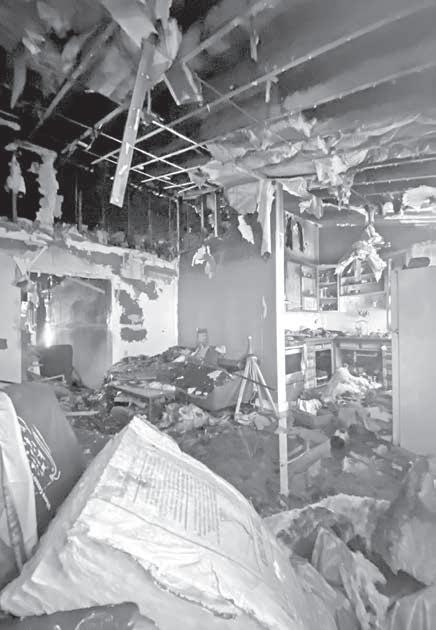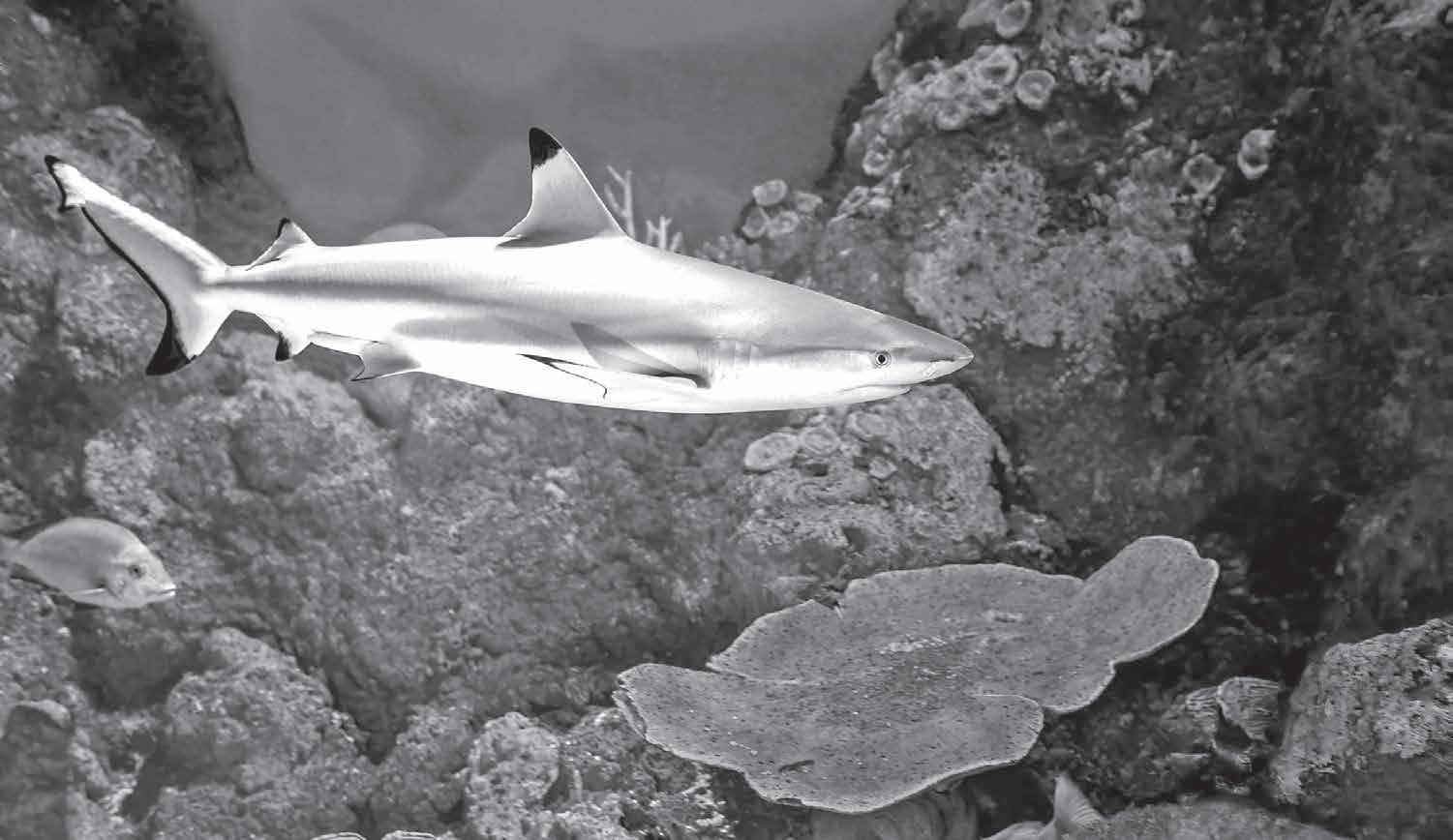
18 minute read
Husband rescues wife from attack
A black tip reef shark. DAVID CLODE/Unsplash
WOMAN BITTEN BY SHARK NEAR SUMMERLAND UNDERGOING SURGERIES
Family of four was swimming when husband heard a big splash
ATexas woman swimming with her family not far from Summerland Key on June 29 knew something wasn’t right when she felt instant pain coming from her leg.
Immediately, the 35-year-old got back onto a boat with help from her husband, surfacing with a visible leg injury from what looked to be a shark bite.
An incident report by Florida Fish & Wildlife Conservation Commission released on July 5 states that the family of four stopped their pontoon vessel on the gulfside east of Sawyer Key around 8 p.m. to jump in the clear, calm water for a swim. They were in about 10 feet of water.
When the woman, identified as Lindsay Bruns, jumped into the water, her husband, Luke, heard a huge splash and turned to see lots of splashing and water coming over into the vessel. He described the splash as too big for his wife just jumping into the water.
The husband reported that he saw nothing but blood in the water. His wife appeared from the water screaming for help, at which time he jumped into the water to retrieve her. He helped her onto the ladder and into the vessel to discover a large wound in her right leg. Per the FWC report, it was consistent with a shark attack. The husband began to apply a tourniquet in an attempt to stop the profuse bleeding.
Florida Fish & Wildlife Conservation officers received the call at 8:09 p.m. They rode to Niles Channel on the gulfside, near Tonio’s Restaurant, when they saw the pontoon boat. FWC officers boarded the boat when they saw what’s described as a half-circle wound on her right leg extending from the hip to just above the knee.
“The cut appeared to be from a serrated impact, and there were puncture marks on her thigh, consistent with a shark attack,” the report states.
FWC officers began to apply a tourniquet. Monroe County Fire Rescue arrived to finish applying the tourniquet. They transported Bruns to a nearby airport where Trauma Star flew her to Jackson South Medical Center for further care. FWC officers remained on scene to help clean the boat while Luke Bruns attended to his children. Officer Cobb drove the vessel back to the residence where the Bruns were staying.
According to a Monroe County press release, the woman received a blood transfusion during the flight. According to Trauma Star staff, the blood transfusion onboard strongly contributed to her status upon arrival in Miami.
“The biggest thing for us was the fact that it wasn’t a boating accident,” said Jason Rafter, public information officer with the Florida Fish & Wildlife Conservation Commission.
The hospital also confirmed the patient’s wound was a shark bite. She remains hospitalized. According to Rafter, the woman is doing well considering the injury.
“Surgeries have been a success so far,” he told the Keys Weekly. “I spoke to her husband and she was doing quite well considering what happened.”
Monroe County has seen two reported shark bites in recent months. On April 17, a man hanging out with friends at the Islamorada sandbar near Whale Harbor was reportedly bitten. His neighbor, Ash Kumar, of Islamorada, was with him during that Sunday afternoon.
Kumar told the Keys Weekly that the group of eight people was standing around in waistdeep water when one of the guys felt something touch his leg. All of a sudden, Kumar’s neighbor said something grabbed him. He pulled his leg up and said “what was that?”
Thankfully, two firefighters were with the group. They quickly retrieved a towel to tightly wrap the leg. A Coast Guard vessel was near the sandbar as the incident unfolded. The crew was signaled over to render aid and get him on land where he was transported to Mariners Hospital.
“The water was murky and nobody saw it,” he said. “Whatever shark it was, it didn’t take a full bite and leave with the calf.
“You can see the tooth mark in there,” he continued.” From outside, it looks clean, but part of that wound was the leg pulling away. It (the shark) grabbed the leg and realized it’s not a fish and took off.”
The man has recovered from the incident.
Data from the Florida Museum of Natural History’s International Shark Attack File states that shark bites picked up in 2021 following three previous years of decline. The U.S. led the world in shark bites last year with 47. Of those incidents, Florida had 28.
As for the bites reported in Florida, research from the Florida Museum states that blacktip sharks are likely responsible for the majority of the incidents. These small sharks hunt in warm water near shorelines where they use shallows to avoid predators of their own, including great hammerheads and bull sharks.
“The shallow water and turbulent waves in surf zones kick up sediment that make it hard for sharks to sight their prey,” said Gavin Naylor, director of the Florida Museum’s shark research program. “About 60% of all bites we record are in low visibility water.”
Two other shark bite incidents were recently reported in Florida. A teenage girl scalloping in 5 feet of water near Grassy Island, just off Keaton Beach, was bitten in the leg by a shark on June 30. According to the Taylor County Sheriff’s Office, Addison Bethea was airlifted to Tallahassee Memorial Hospital Health Care for emergency surgeries. On July 5, multiple news outlets reported that Bethea was set to undergo amputation above the knee.
And according to a WFLA report, a Dayton Beach man was bitten on the foot by a shark on the morning of July 3. The report states that a 29-year-old man was swimming in New Smyrna Beach when he was bitten. The man was taken to the hospital with minor injuries.
SAFE AND SOUND
Stolen French bulldog returned from Miami to Marathon owners
ALEX RICKERT
alex@keysweekly.com
Thanks to a fast-acting collaboration between the Monroe County Sheriff’s Office and the Miami-Dade Police Department, a dog stolen from her home neighborhood in Marathon and taken all the way to Miami is safely back at home.
On July 4, Reinier Fuentes, 33, and Lilianne Dominguez, 26, were arrested on charges of grand theft, dealing in stolen property and use of a two-way communication device to facilitate a felony. The two were booked into jail in Miami-Dade County.
The case began just over a week earlier when Marathon resident Patti Rhine noticed that her husband’s service dog, a French bulldog named Sailor, had gone missing. Within minutes, Patti began searching her neighborhood, a series of dead-end streets, but Sailor was nowhere to be found.
According to Rhine, she received a call later that night from an individual claiming to have Sailor. After sending Rhine a picture of the dog to confirm Sailor’s identity, Rhine said the caller switched to a service obscuring the incoming number, and his story failed to add up.
Rhine said the caller told her that Sailor was found in Islamorada and claimed the dog was abused. Making claims that he had to spend money on Sailor for medical treatment, Rhine said the caller told her that he “gave her water right away at Wal-Mart as soon as we found her” and that he was hesitant to return the dog, but never offered his name.
“She didn’t run 30 miles,” Rhine told Keys Weekly. “She would have been dead in 15 minutes.”
Enlisting the help of MCSO, which eventually coordinated with the Miami-Dade Police Department, Rhine said she arranged for an exchange with the caller the next day, backed by undercover MCSO officers.
As a valuable target for dog thefts, French bulldog puppies are frequently sold for up to $3,000. Although Rhine said she informed the caller that Sailor was spayed and would be useless for breeding purposes, she eventually found that the dog’s belly had been shaved in the usual site of the surgical incision for the procedure.
Demanding $1,000 for Sailor’s safe return, Rhine said, the caller changed the location for the exchange several times.
“The guy was really arrogant,” said Rhine. “He goes, ‘You can meet me anywhere. I’ll even go to the police station.’”
After failing to arrive at the designated police station for the exchange, Rhine said the callers became more aggressive.
“(Dominguez) started yelling at me,” she said. “They were getting nervous. … She said, ‘Be at Dadeland Mall. You leave right now and you can have your dog. If you don’t, you’ll never see her again.’”
Upon meeting Fuentes, Dominguez and their young daughter at the mall and exchanging marked bills for Sailor, the adult suspects were handcuffed but eventually released by Miami-Dade officers.
“I was shocked when they called me and told me that they were let go,” said Monroe County Sheriff Rick Ramsay. “I couldn’t believe it.”
Although the suspects claimed to have found Sailor in Islamorada, according to Ramsay, MCSO detectives determined using video footage that Dominguez had been in Marathon working for a house cleaning service at the house next to Rhine’s at the time Sailor had gone missing.
“It put them at the crime scene, and not as a good Samaritan trying to pick up a dog who’s running loose,” said Ramsay. Using the information obtained throughout the exchange process and Rhine’s account of her experience, MCSO obtained arrest warrants for Fuentes and Dominguez.
“I can’t speak on behalf of Miami-Dade County, but that crime took place here in Monroe, and they are going to jail,” said Ramsay.
Within days, the pair were again located and arrested by Miami-Dade officers.
Rhine expressed her extreme gratitude for the work of both agencies, as well as family friends Andrew George and Carolyn Campbell, who accompanied her to Miami and had the foresight to mark the bills eventually used in the exchange.
“MCSO did awesome,” said Rhine. “I can’t say enough nice things about them. … I’m very proud of our Marathon community.”
“We treated this like someone’s child,” said MCSO Capt. Don Hiller. “That’s how important this is. My guys were pretty relentless, and it was a great outcome.”
“The people that work for the sheriff’s office, they get how important this is, that this is someone’s family member,” said Ramsay. “They’re on weekends and after hours working on this case, so I’m proud of the men and women who dealt with this matter, from patrols to detectives to the administrative portion of this case.

Reinier Fuentes, right, and Lilianne Dominguez are detained by MiamiDade officers for the alleged theft of Sailor. MCSO/Contributed
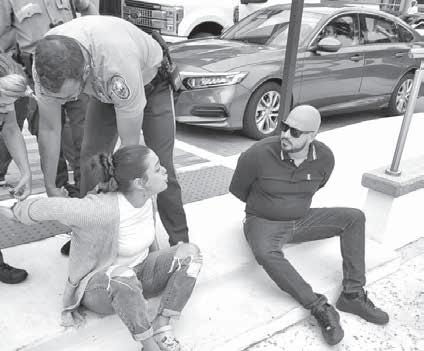
Thanks to the quick work of Monroe County Sheriff and Miami-Dade officers, Sailor is back home with Patti and Mike Rhine. CONTRIBUTED
KEYS ISLAND NAMED AFTER A TREE OF LIFE
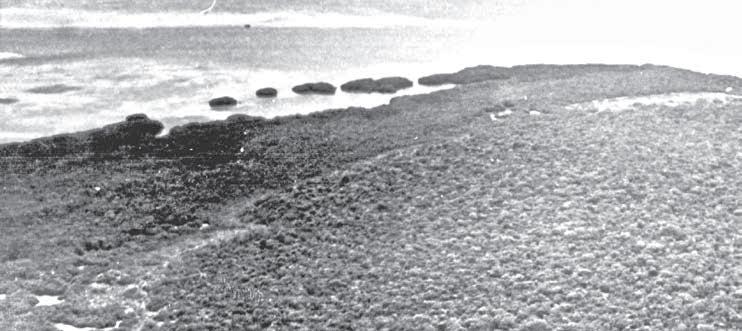
LIGNUMVITAE KEY BOASTS A STORIED PAST
Spoiler alert: the Florida Keys are a lowlying collection of islands that rises, on average, 3.2 feet above sea level. Three islands, however, boast a peak elevation of 18 feet. Solares Hill, the highest point on Key West and home to the Key West Cemetery, stands at 18 feet, as does a point on Islamorada’s Windley Key. Lignumvitae Key, too, has a place that reaches a peak elevation of 18 feet.
Only a handful of the approximately 1,700 islands making up the Florida Keys archipelago were linked to the mainland by the Key West Extension of Henry Flagler’s Florida East Coast Railway or the wood, concrete and asphalt of the Overseas Highway. When people talk about or write about the Florida Keys, it is usually about one of the 50 or so islands that have been connected by one conduit or the other. There are thousands of histories grounded on those less-connected Keys, and Lignumvitae Key is home to one of the great often-overlooked Florida Keys stories.
The 280-acre island is in the Islamorada area of the Upper Keys, and even though it is visible from the Overseas Highway, it is also one of those islands that are super easy to drive by without even taking notice. The island can be seen in Florida Bay from the slightly arched vantage point of the Indian Key Bridge at about Mile Marker 77.5. Out in the bay, Lignumvitae Key appears as just another low-lying mangrove island. It is located about a mile from the highway.
One of the distractions that make it easy to overlook the island comes in the form of the iconic Alligator Reef Lighthouse standing on its iron, skeletal legs out on the Atlantic horizon. It also does not help that while driving from Upper Matecumbe to Lower Matecumbe Key and rolling gently up and over the Indian Key Bridge, colorful Robbie’s Marina presents itself as one of the last of the great roadside attractions. It is an absolute eye-catcher.
Lignumvitae Key was historically overlooked because the relative shallows surrounding the island made for a difficult approach for the cumbersome ships sailed by European explorers. However, the island was not completely ignored. For all the history connected to the island, Lignumvitae Key has managed to retain much of its integrity. Unlike many of the other islands of the Florida Keys, especially those that were connected by the train or the highway, Lignumvitae Key is still forested by a virgin sub-tropical hammock.
The island is named after the tree of life, the lignum vitae tree. Like the island, the tree has a remarkable history. Stories say that the lignum vitae tree grew in the Garden of Eden and that the Holy Grail was carved from its wood. The tree produces an exceedingly dense wood that is not only strong but considered relatively inflammable as far as wood goes. Chipped up and muddled, the wood of the lignum vitae tree has an impressive list of curative properties. Not only was it used to cure syphilis, but its pharmaceutical counterparts range from Xanax to Viagra.
Lignum vitae trees grow thick on the island that was once called Cayo de la Lena, or Firewood Key, on an unnamed 1769 Spanish chart. English cartographer Bernard Romans identified the island as Lignum Vitae Kay on his 1774 chart, and the name has, for the most part, stuck ever since. The island, known as Lignumvitae Key Botanical State Park today, is another example of what Florida does best: set aside land for its park system.
The island’s earliest explorers were the people known as the Matecumbe culture of Indians. Evidence of their interaction with the island comes in the form of a rarity in the Florida Keys, a prehistoric Indian burial mound. There are stories passed around about the burial mound that are astonishing. People say the bones of a Calusa Indian who stood more than 8 feet tall were buried on the island, though none of the bones discovered within the mound fit the bill of that alleged account. Stories of these giant people are bandied about on the outskirts of historical research. It is crucial to remember that while the aboriginal people of South Florida and the Keys stood taller than Europe’s explorers, they were not giants. Hundreds of years ago, the average height of the European male was about 5 feet 5 inches tall, whereas the average aboriginal male stood closer to 6 feet tall.
The prehistoric teardrop-shaped sand burial mound discovered on Lignumvitae Key covers approximately 200 square feet and rises to an elevation of 3 to 4 feet. Human bones were discovered around the site and about 7 inches below the surface. Carbon dating of a skull taken from the mound revealed it to be about 1,800 years old. Other bones uncovered in the mound were dated between 800 to 1,400 years old.
The Indians were not the last to use the island. In next week’s column, we will explore more history of Lignumvitae Key Botanical State Park and its connection to Indian Key Historic State Park. Stay tuned.

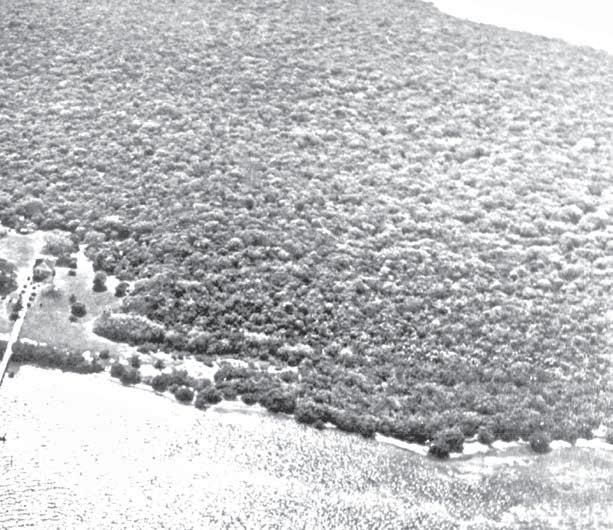
BRAD BERTELLI is an author, speaker, and Florida Keys historian. His latest book, “The Florida Keys Skunk Ape Files,” is a fun blend of two of his favorite subjects — Florida Keys history and the Skunk Ape.

TIFFANY DUONG
tiffany@keysweekly.com
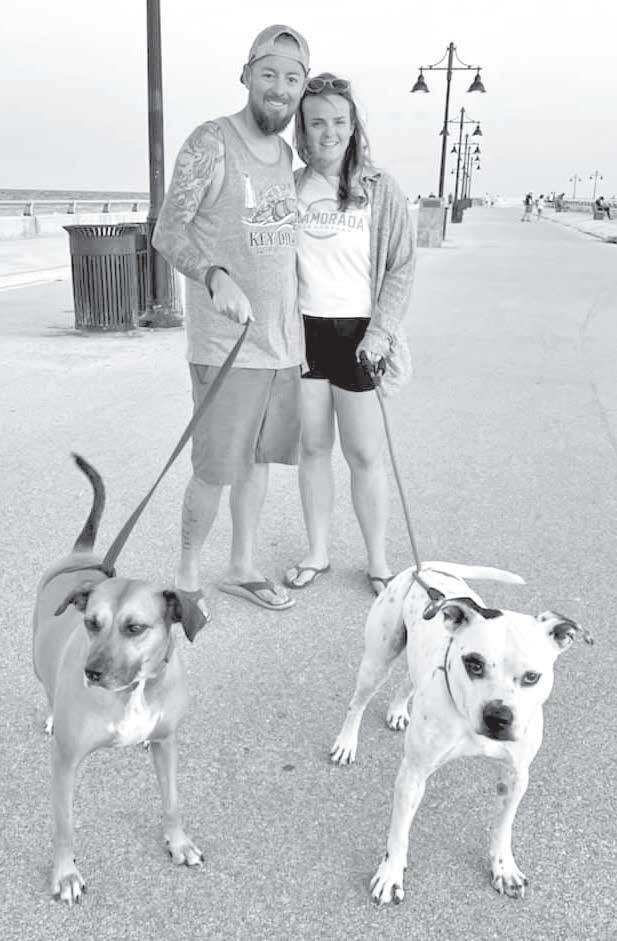
LOCALS LOSE EVERYTHING IN FIRE, BUT RESCUE THEIR DOGS
“The house is on fire, and we cannot get your dogs out.” Justin Benson and Bailey Thomasson were celebrating a friend’s birthday at Lost & Found bar in Key West when their landlord called them, hysterical. A woodshop fire had jumped to the landlords’ side of the duplex and spread to Benson and Thomasson’s.
The couple, who work as a boat captain and a coral restoration practitioner, respectively, ran to their bikes, fumbling to unlock them. “I have never pedaled so hard,” Thomasson said. “We raced down Duval and approximately 1.5 miles of road to our house. From the amount of time that we watched the smoke and how big it was … I knew the dogs were going to be dead. I couldn’t imagine how they could survive something that big.”
Some believe it was Key West’s largest fire in decades. Benson described having “tunnel vision” seeing black plumes of smoke over Key West. He willed the dogs to be alive.
As they approached, he saw flames from the neighbor’s duplex going 40 feet or more into the air. There were two fire trucks and many firefighters dousing the flames. Benson ran past them. “I don’t remember thinking about it, just going in,” he said. “It was like hitting a brick wall of white smoke, where you couldn’t breathe or see anything more than a foot away. I … just covered my face and felt my way to the dog crate for Jib while yelling for Sadie.”
Sadie is a North Carolina rescue. She’s about 5 years old and helped Thomasson move to Florida to start her new career. “You hear people talk about their ‘soul dogs,’ and Sadie is definitely mine,” said Thomasson. “She’s been my best friend for the last few years.”
Jib is a rescue from the Florida Keys SPCA in Key West – a true Conch, Benson said. He’s 3 to 4 years old and a “hugger” who won’t let go sometimes, Thomasson added. “His smile will get you every time.”
Within a minute of entering, Benson crawled into his and Thomasson’s bedroom, where Jib’s dog crate was. By luck, that room was the last on the entire property to burst into flames. Jib was just standing there, “ears just so excited to see me,” Benson said. He felt relieved to see his dog alive. Benson also knew that Sadie would be hiding nearby.
By the time Benson reached the dogs, nearly half an hour had elapsed from the start of the fire. He grabbed Jib and called Sadie’s name. Sure enough, she emerged, and a firefighter nearby grabbed her. Everyone got out safely, and EMTs put Benson and both dogs on oxygen.
“They were both still alert and, outside of bloodshot eyes, have made an amazing recovery,” said Benson, “which we are so incredibly grateful for.”
Thomasson knew her boyfriend was going in no matter what, because “that’s just the type of person he is.” When everyone was safe and Benson started dry heaving from the smoke, she realized what he’d risked. “I was SO upset with him for going inside and putting himself through that, but so incredibly grateful because he was the reason we were sitting outside together hugging Sadie and Jib,” she said. “He’s my best friend always, but I have a completely new respect and love for him.”
The pair stayed several hours, watching everything they own go up in flames. The biggest loss was Benson’s inventory for his apparel company, Wanderlust Hats. The two-year-old passion project was gaining traction, but now everything’s gone, Thomasson said.
Firefighters used an unprecedented amount of water, spraying from around 8 p.m. until 4 a.m. the next day. Their home is a “total loss,” with damage from both the fire itself and the water used to extinguish it. “Outside of the clothes we had on and rescuing the two dogs, we don’t think anything else will be salvageable,” Benson said.
The Keys community countered the tragedy with support, kindness and donations. Having just moved from the Upper Keys in January, the couple didn’t know many people. However, this experience brought them “so close” to people who were complete strangers before, Thomasson said. Key West businesses 22&co and Mary Ellen’s hosted charity bingos and vibrator races to their benefit. The owner of Captain’s Corner, where Benson works, gave them a temporary place to stay.
“I really don’t have the words to say how amazing people are. The Keys/Key West community is unlike anything I could’ve imagined,” Thomasson added. “The biggest silver lining for me is how supported we feel by this community. We can’t wait to get back on our feet to a place where we can do this for others in the community who also need help.”
Thomasson and Benson are looking for a permanent place to live. A GoFundMe has been established at https://www.gofundme.com/f/ justin-baileys-house-fire-in-key-west to help give them a new beginning. A similar campaign exists to help their landlords at https://gofund. me/ef78107a.
Left: Keys locals Bailey Thomasson and Justin Benson celebrate being safe with their dogs Sadie and Jib after their house burnt down. CONTRIBUTED
Bottom: A huge fire destroyed a local couple’s home and all their belongings. JUSTIN BENSON/Contributed
